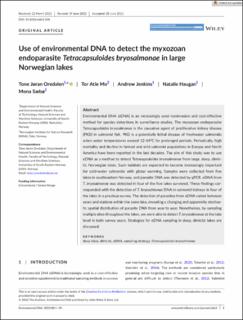Use of environmental DNA to detect the myxozoan endoparasite Tetracapsuloides bryosalmonae in large Norwegian lakes
Peer reviewed, Journal article
Published version

Åpne
Permanent lenke
https://hdl.handle.net/11250/3013577Utgivelsesdato
2022Metadata
Vis full innførselSamlinger
- Publikasjoner fra CRIStin - NINA [2364]
- Scientific publications [1392]
Sammendrag
Understanding the underlying causes behind human–elephant conflict (HEC)-driven mortality of humans and Environmental DNA (eDNA) is an increasingly used noninvasive and cost-effective method for species detections in surveillance studies. The myxozoan endoparasite Tetracapsuloides bryosalmonae is the causative agent of proliferative kidney disease (PKD) in salmonid fish. PKD is a potentially lethal disease of freshwater salmonids when water temperatures exceed 12–14°C for prolonged periods. Periodically, high mortality and decline in farmed and wild salmonid populations in Europe and North America have been reported in the last decades. The aim of this study was to use eDNA as a method to detect Tetracapsuloides bryosalmonae from large, deep, dimictic Norwegian lakes. Such habitats are expected to become increasingly important for cold-water salmonids with global warming. Samples were collected from five lakes in southeastern Norway, and parasite DNA was detected by qPCR. eDNA from T. bryosalmonae was detected in four of the five lakes surveyed. These findings corresponded with the detection of T. bryosalmonae DNA in salmonid kidneys in four of the lakes in a previous survey. The detection of parasites from eDNA varied between years and stations within the same lake, revealing a changing and apparently stochastic spatial distribution of parasite DNA from year to year. Nonetheless, by sampling multiple sites throughout the lakes, we were able to detect T. bryosalmonae at the lake level in both survey years. Strategies for eDNA sampling in deep, dimictic lakes are discussed. deep lakes, dimictic, eDNA, sampling strategy, Tetracapsuloides bryosalmonae
